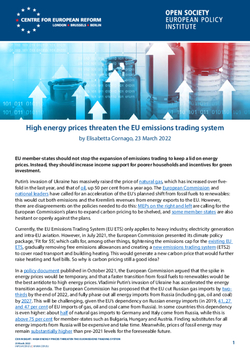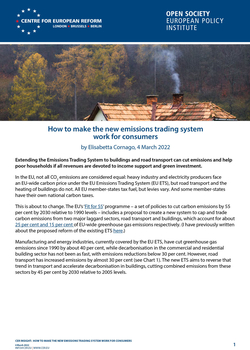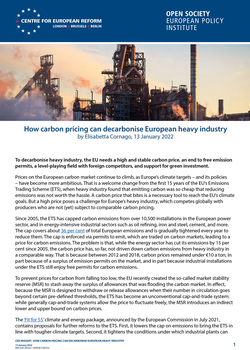
High energy prices threaten the EU emissions trading system
EU member-states should not stop the expansion of emissions trading to keep a lid on energy prices. Instead, they should increase income support for poorer households and incentives for green investment.
Putin’s invasion of Ukraine has massively raised the price of natural gas, which has increased over five-fold in the last year, and that of oil, up 50 per cent from a year ago. The European Commission and national leaders have called for an acceleration of the EU’s planned shift from fossil fuels to renewables: this would cut both emissions and the Kremlin’s revenues from energy exports to the EU. However, there are disagreements on the policies needed to do this: MEPs on the right and left are calling for the European Commission’s plans to expand carbon pricing to be shelved, and some member-states are also hesitant or openly against the plans.
Currently, the EU Emissions Trading System (EU ETS) only applies to heavy industry, electricity generation and intra-EU aviation. However, in July 2021, the European Commission presented its climate policy package, ‘Fit for 55’, which calls for, among other things, tightening the emissions cap for the existing EU ETS, gradually removing free emissions allowances and creating a new emissions trading system (ETS2) to cover road transport and building heating. This would generate a new carbon price that would further raise heating and fuel bills. So why is carbon pricing still a good idea?
In a policy document published in October 2021, the European Commission argued that the spike in energy prices would be temporary, and that a faster transition from fossil fuels to renewables would be the best antidote to high energy prices. Vladimir Putin’s invasion of Ukraine has accelerated the energy transition agenda. The European Commission has proposed that the EU cut Russian gas imports by two-thirds by the end of 2022, and fully phase out all energy imports from Russia (including gas, oil and coal) by 2027. This will be challenging, given the EU’s dependency on Russian energy imports (in 2019, 41, 27 and 47 per cent of EU imports of gas, oil and coal came from Russia). In some countries this dependency is even higher: about half of natural gas imports to Germany and Italy come from Russia, while this is above 75 per cent for member-states such as Bulgaria, Hungary and Austria. Finding substitutes for all energy imports from Russia will be expensive and take time. Meanwhile, prices of fossil energy may remain substantially higher than pre-2021 levels for the foreseeable future.
Higher carbon prices are needed to strengthen incentives to cut emissions – for example by reducing energy consumption, shifting from fossil fuels to renewables for electricity generation.
But this is not a reason to freeze plans to make EU carbon prices bite harder and to expand emissions trading to more sectors of the economy. Higher carbon prices are needed to strengthen incentives to cut emissions – for example by reducing energy consumption, shifting from fossil fuels to renewables for electricity generation, and electrifying processes that would otherwise require fossil fuels. Additionally, many ETS emissions permits are auctioned (although not enough of them), bringing in revenues that governments can re-invest in the energy transition. Part of the revenues from the existing ETS go towards funds for green innovation and for the modernisation of power systems. The Commission wants some of the revenues from ETS2 to go to a new EU fund, the Social Climate Fund (SCF). This fund would be distributed among member-states to help vulnerable consumers with higher energy bills, and to finance subsidies for green investment by households and businesses – such as building renovations, installation of heat pumps, and replacement of combustion engine cars with electric vehicles and bikes.
Quitting Russian fossil fuels will mean moving to more carbon-intensive alternatives such as coal in the short term – carbon prices are particularly important because they will help to ensure this shift is only temporary, not the new normal. In the past few months, lower Russian gas pipeline imports have partially been replaced by higher imports of liquefied natural gas, and by coal to power electricity generation. Switching away from gas might help to keep European industry going and avoid larger cuts to energy demand, but Europe is very dependent on Russian oil and coal as well. While still expensive due to increased competition with other fuel buyers, sourcing alternatives to Russian oil and coal would be somewhat easier than Russian gas, given that global markets for these commodities are more fluid. Swift approval of reforms of the ETS and implementation of ETS2 would provide the necessary certainty for investors to plan ahead and increase investment in renewables and energy efficiency.
Quitting Russian fossil fuels will mean moving to more carbon-intensive alternatives such as coal in the short term – carbon prices are particularly important because they will help to ensure this shift is only temporary, not the new normal.
EU member-states need to act on two fronts – both demand and supply of energy – and on two timescales. They must reduce fossil fuel imports from Russia as rapidly as possible, even if that means procuring more polluting fossil fuels in the short term. At the same time, they must keep their eyes firmly anchored on 2030 and 2050 climate goals. On the supply side, governments should immediately facilitate accelerated investments in renewable energy, but also in waste-based biogas and in green hydrogen. On the demand side, they should encourage energy efficiency improvements and the use of low-carbon solutions such as electric vehicles and heat pumps, to cut consumption of oil and gas. Both supply and demand measures are critical to reducing dependence on Russia. Carbon prices are the most efficient way to incentivise both types of measures – but they are also politically difficult.
Governments might be tempted to shield consumers from high energy prices. In its ‘RepowerEU’ communication of March 8th, the European Commission highlighted that governments could temporarily cut energy taxes and cap electricity retail prices. Many EU governments have already cut VAT and energy taxes since the October price spike, and are now considering similar measures for fuel at the pump. But artificially limiting energy prices amounts to providing fossil fuel subsidies and would dim the incentive to reduce energy consumption that high prices provide. Europe needs to adjust to a period of higher and more volatile energy prices – fossil fuel subsidies are neither helpful for decarbonisation nor tenable for public budgets. Instead, governments should give unconditional transfers to consumers, making them more generous for the most vulnerable. That way, high energy prices will encourage households and businesses to reduce energy consumption and invest in energy efficiency, while cash transfers will allow those who can’t afford to do so to pay their bills. Support for energy efficiency investment, already a priority of the Recovery Fund, should first and foremost address poorest households, who otherwise would find it difficult to renovate or heat their homes.
Pausing efforts to expand the coverage of European carbon prices is the wrong way to go about this energy crisis. The EU should keep its carbon pricing plans, reforming the existing ETS by swiftly removing free allowances while a carbon border adjustment mechanism is introduced, and creating a new ETS covering road transport and heating, backed up with a Social Climate Fund.
ETS2 is proposed to start in 2026, but a Social Climate Fund would start operating in 2025 in order to front-load energy efficiency investment by households and businesses. In a previous article, I argued it would make sense to bring the SCF forward, making its disbursement start in 2024. Given the urgency of redistributing the cost impacts of the energy crisis, compounded by the war in Ukraine, it would make sense to bring this forward further. The SCF could start as soon as possible, financed with EU joint borrowing and, later, revenues from auctions of emissions permits.
Leaving carbon unpriced is not just: carbon pricing is a tool to make climate action equitable, by making polluters pay and using revenues to help the most vulnerable reduce their dependence on fossil fuels.
Critiques of extending emissions trading to consumer-oriented sectors such as heating and road transport complain about the distributional impacts of higher energy prices. That is a valid critique, but fails to recognise that making good use of revenues from ETS2 would make the scheme progressive. Leaving carbon unpriced is not just: carbon pricing is a tool to make climate action equitable, by making polluters pay and using revenues to help the most vulnerable reduce their dependence on fossil fuels.
Elisabetta Cornago is a senior research fellow at the Centre for European Reform.
Note: This is the third of a series of insights on the EU Emissions Trading System, and the proposed changes to it presented within the climate policy package Fit for 55. Read the first and second insight of this series.
This paper is published in partnership with the Open Society European Policy Institute.




Add new comment